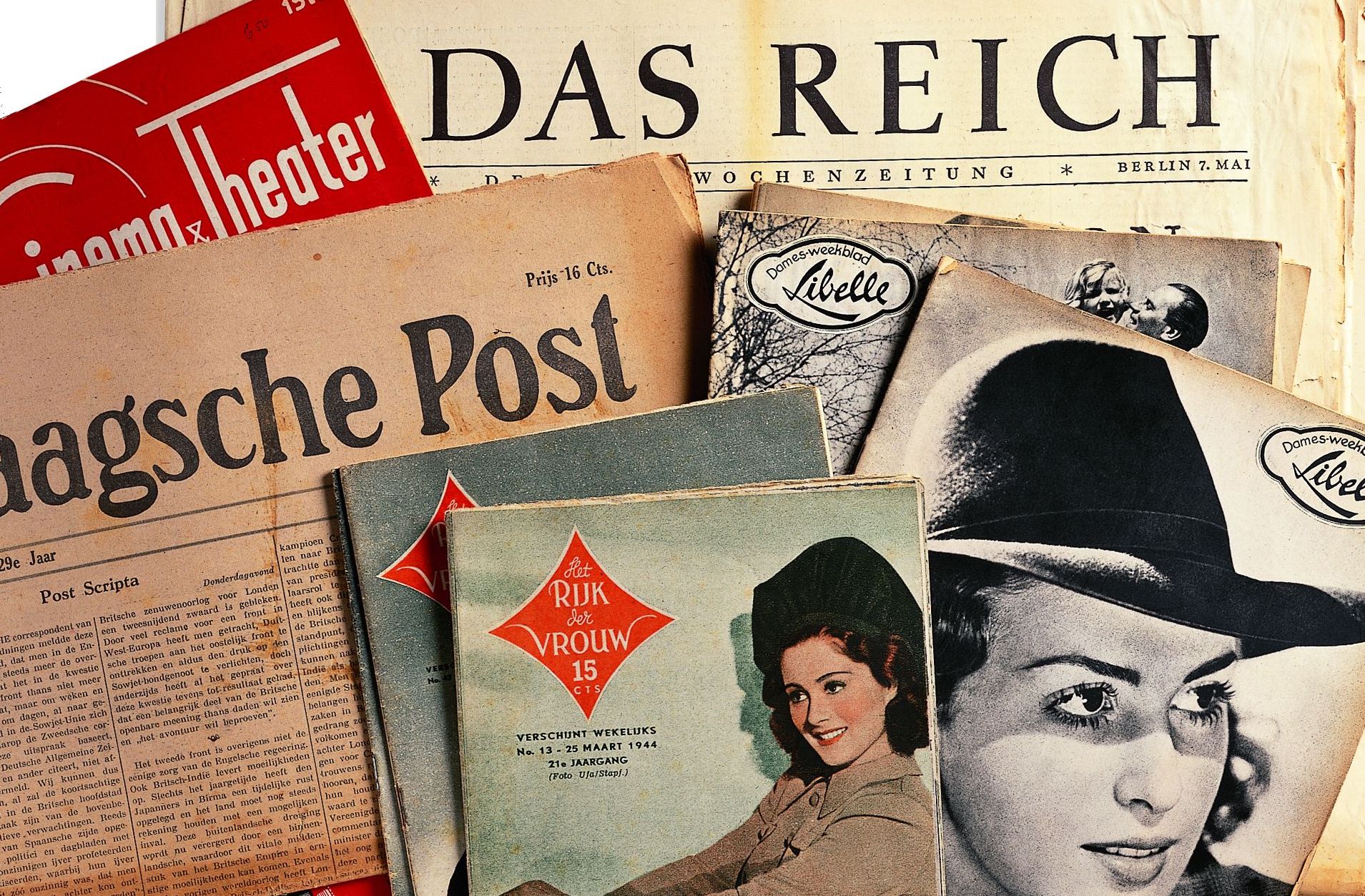Rijk der Vrouw, Het
Het Rijk der Vrouw, weekly magazine (1924-1949).

Diverse tijdschriften
Fotograaf: Allard Bovenberg. Collectie: Anne Frankl Stichting Copyright: AFS rechthebbende
On 18 April 1944, Anne Frank writes: "Mr. Kugler is getting better and better at supplying us with journals, each week Cinema & Theater, many Prinsen and Rok der Vrouw, each week Haagsche Post, sometime das Reich and others."[1]
The modern illustrated women's magazine had its origins during the Interwar period, with the publication of Het Rijk der Vrouw (Women's Realm) in 1924.[2] 'Another new magazine for ladies, many readers will ask in wonder'. With these words the first issue of Het Rijk der Vrouw was announced in 1924. The weekly magazine hastened to remove any skepticism by reporting that it would operate in the broadest possible area, 'and in return set the subscription price so low that Het Rijk der Vrouw is within everyone's reach.' Not only (self-made) fashion and 'feminine handicrafts' (in this issue airy summer dresses and 'nice sailor suits') but also home furnishings, practical information about housekeeping and cooking, the 'interests and rights of women', in short, everything that is even remotely important for our readers' would be discussed in detail.[3] This broad design turned out to meet a great need. Later magazines such as Libelle (1934) and Margriet (1938), just like Het Rijk der Vrouw, aimed at women for whom family life is central, still follow the same success formula. [4]
The first issue of Het Rijk der Vrouw rolled of the presses of Sijthoff publishers in Leiden. Amy Vorstman-ten Have was editor-in-chief of Het Rijk der Vrouw for seven years, which she, in her own words, 'largely wrote on her own, without the cooperation of others'.[5] In 1931. the magazine was taken over by the Nederlandsche Rotogravure Maatschappij in Leiden, also publisher of Cinema & Theater. As of January 1942, both magazines were published by Opbouw Publishers of the German National Socialist publisher Johann Kasper.[6] In October 1949, Het Rijk der Vrouw was merged with Eva, a magazine founded in 1942 that would continue as Viva in 1972.[7]
Footnotes
- ^ Anne Frank, Diary Version A, 18 April 1944, in: The Collected Works, transl. from the Dutch by Susan Massotty, London [etc.]: Bloomsbury Continuum, 2019.
- ^ Tom van der Linden, Spaarnestad-fotografen: broodfotografen of unieke beeldkunstenaars? Een onderzoek naar de fotografie van uitgeverij De Spaarnestad tussen 1910 en 2000, Master thesis Media & Journalistiek, Erasmus Universiteit Rotterdam, 2013, p. 23. The list of Dutch-language women's magazines on Wikipedia lists two magazines with the same title: Het Rijk der Vrouw (1914-1949) and Het Rijk der Vrouw (1932-1990). Wikipedia: Lijst van Nederlandstalige vrouwentijdschriften. The latter was a Belgian magazine founded in 1924. The first issue appeared on 3 January 1925. Its original title was Het Modeblad. It was published as the Flemish sister magazine of Femmes d'Aujourd'hui. The magazine was renamed Het Rijk der Vrouw in 1931 after it was redesigned. Wikipedia: Het Rijk der Vrouw.
- ^ See: Joan Hemels & Renée Vegt, Het geïllustreerde tijdschrift in Nederland: bron van kennis en vermaak, lust voor het oog. Bibliografie. Deel I: 1940-1945, Amsterdam: Otto Cramwinckel, 1993, p. 363-364; Elsbeth Kwant, Marieke van Delft, Reinder Storm (samenst. & red.), Het Tijdschriftenboek, Zwolle: Waanders, 2006, p. 320.
- ^ Linda Duits, Een kleine geschiedenis van het vrouwenblad. Diep Onderzoek, 24 maart 2024.
- ^ Reinildis van Ditzhuyzen, 'Have, Amelie Jeanne ten (1887-1959)', in: Biografisch Woordenboek van Nederland. Teh Have was dhe author of the best-selling Dutch etiquette book of all time: Hoe hoort het eigenlijk? (How to behave?) (1939).
- ^ Various volumes of Het Rijk der Vrouw can be accessed on Delpher, the Royal Library's website of digitized historical Dutch newspapers, books, magazines and radio bulletins from libraries, museums and other heritage institutions
- ^ Wikipedia: Viva (tijdschrift).